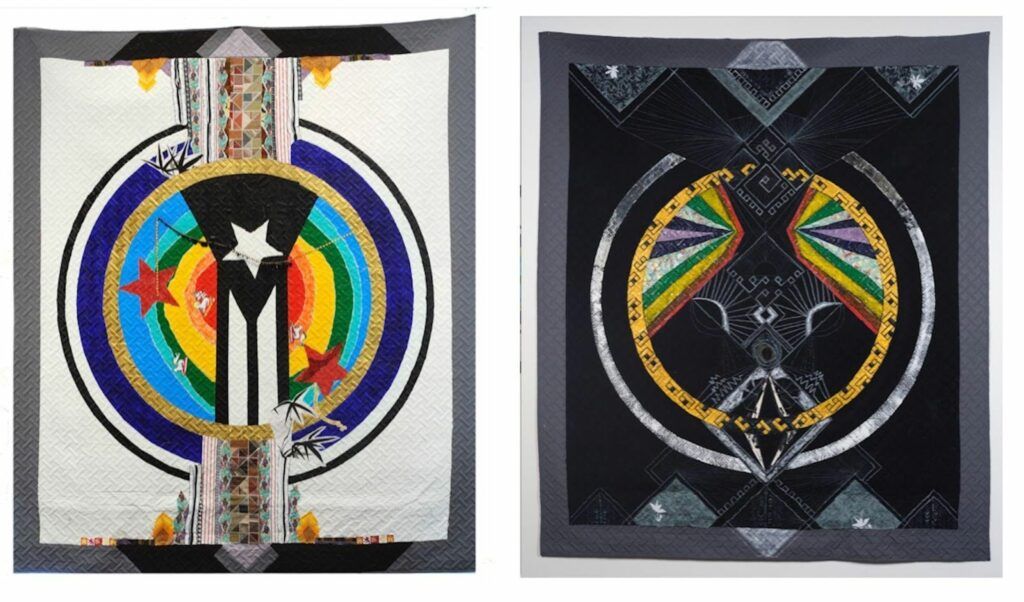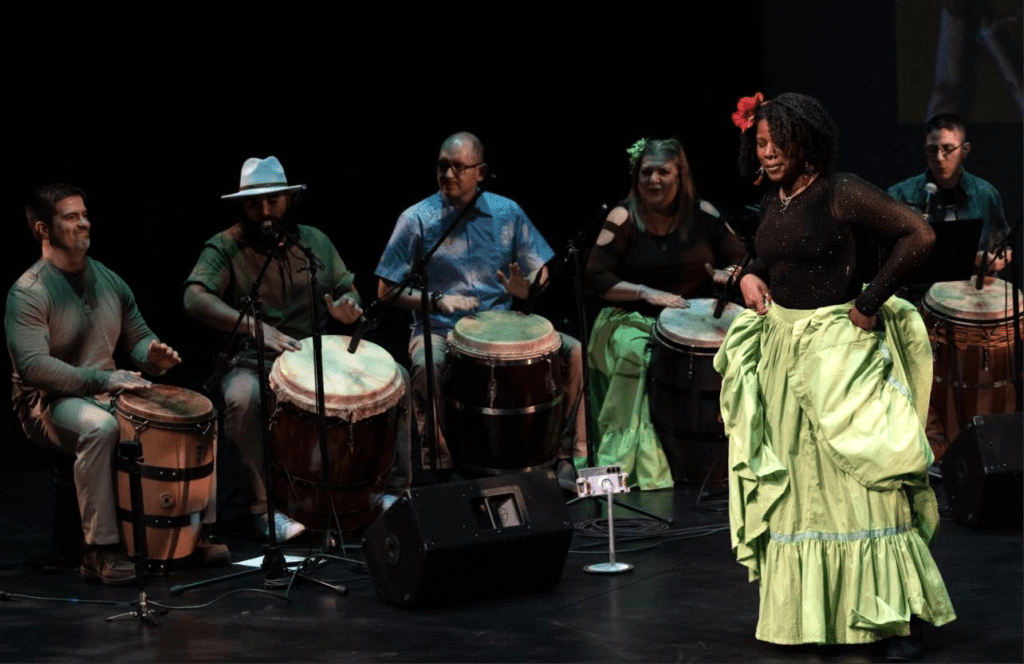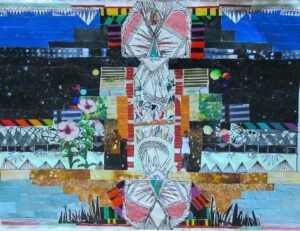Working in the arts was something I never envisioned for myself, considering my background as a Human Rights lawyer in my home country, Venezuela. My early career was defined by advocating for justice and addressing the critical challenges faced by vulnerable communities. But life often has a way of leading us to unexpected places, and an unanticipated alignment of paths eventually guided me into the world of arts and culture—a space where storytelling, identity, and social justice converge in similar ways.
This shift has allowed me to immerse myself in the vibrant cultural landscape of Washington, D.C., where I discovered the potential of art as a powerful tool for dialogue, resistance, and healing, and along the way, I’ve been fortunate enough to cultivate meaningful bonds with a multitude of artists, each offering unique perspectives that have enriched my understanding of the artistic process. Among these, my connection with Amber Robles-Gordon stands out. Her work and vision have profoundly shaped my appreciation of art as more than a solitary pursuit, but a dynamic, community-centered force that thrives on collaboration, shared histories, and collective storytelling. Robles-Gordon’s practice has illuminated for me the power of art to build bridges, spark dialogue, and create spaces where personal and communal narratives intertwine.
Robles-Gordon’s art is a profound and layered examination of identity, culture, and memory, intricately expressed through a blend of mixed media, collage, textile techniques, public installations, and performance. Each medium she employs serves as a tool for exploration, allowing her to delve into the complexities of her Afro-Puerto Rican heritage and the multifaceted nature of her existence. As an artist born in the Commonwealth of Puerto Rico and raised in the Commonwealth of Virginia, her creative journey is deeply shaped by the intersection of her dual cultural identities, reflecting the interplay between her island roots and her experiences navigating life in continental United States.
These two “commonwealths,” each with its own political and cultural significance, serve as metaphors for the duality and hybridity that characterize her identity. The term “commonwealth” itself suggests a collective benefit, yet for Robles-Gordon, it evokes the complexities of belonging to two places that share a historical connection to colonialism, but have differing experiences of it. Puerto Rico, an unincorporated US territory with a grievous colonial past, and Virginia, a state with deep ties to the history of slavery and the African diaspora, represent two realms where her identity is simultaneously inherited and contested. In navigating these two spaces, Robles-Gordon’s art emerges as an exploration of what it means to straddle different but related cultural realities. Her practice becomes a dialogue between the island of her birth and the mainland of her upbringing, as she reconciles the rich traditions of her Afro-Puerto Rican heritage with the influences of the broader US cultural landscape. Each “commonwealth” in her life serves as a repository of both personal and collective history, and the artist approaches these complex terrains with courage and curiosity, showing a commitment to embracing the past while staying open to the lessons it offers. Through her work, she pulls from these layered legacies to create a space that merges, reimagines, and redefines her own identity, reflecting on the fluidity of the diasporic experience, where the nuances of history, migration, and cultural transformation twist and tangle continuously.

Looking beyond personal experience, Robles-Gordon’s investigation speaks to broader, shared histories within Indo-Afro-Latinx communities using vibrant materials and forms that highlight their interconnections. It is with an introspective ethnographic approach, that she unearths the complexities of selfhood and lineage, tracing family narratives, oral traditions, archival records, spiritual practices, music and dance. Much of Robles-Gordon’s recent work has been informed by her travels to Puerto Rico, where she revisited the island as an adult, an artist, and an investigator. Through these travels, she has been able to engage deeply with the land, the people, and the stories that shape her heritage, allowing her to explore how these experiences influence her artistic practice, and she aims to convert these lessons of ancestral knowledge into material objects using a symbology of geometric abstraction. Through this pictoric genre, Robles-Gordon aims to create a body of work that feels universally accessible, transcending social boundaries and inviting interpretation from a diverse range of viewers.
Given the deep, immersive engagement the artist has with her heritage, Robles-Gordon’s creative process can be likened to that of an archaeologist—meticulously excavating sites of historical significance to reveal and make sense of the remnants of the past, and using the findings to construct more complete and insightful cultural narratives. Yet, unlike conventional archaeology, her excavation is not concerned with physical vestiges per se, but rather with the conceptual: the memories, the cosmogonies, and the chronicles that serve as the bedrock of her own existence. Each piece she creates serves as a fragment of this ongoing exhuming.
Robles-Gordon’s expansive notion of painting and sculptural form is manifested in a wide range of works that span multiple mediums, all of which—whether two-dimensional, three-dimensional, or performative—aggregate into a cohesive and ever-evolving expression of her artistic vision, which not only unifies the various creative outpours, but emphasizes the interconnectedness of her practice. This integrative methodology is a vivid example of her archeological approach. By combining diverse elements—such as photographs, textiles, drawings, and natural materials—Robles-Gordon creates multi-layered compositions that require the assessment and meaning-making of each individual part as well as the whole. The act of piecing together these components mirrors her journey of reconstructing her complex and intersecting history, and despite the political subordination imposed by colonial systems, she actively seeks to reclaim, reframe, and celebrate her heritage.

2020. Collage, 18 x 24. Image courtesy of the David C. Driskell Center Collection, MD.
Central to Robles-Gordon’s practice is a deepening diligence to honoring and nurturing the legacy of her Afro-Puerto Rican heritage, a commitment that transcends merely preserving the past, but fosters a dynamic and sustained connection to her cultural roots. By paying homage to the craftsmanship of her ancestors, the artist breathes new life into traditional practices, reimagining and transforming them through the lens of contemporary techniques. The tactile quality of her works creates a physical sense of continuity, establishing an unbroken connection between her creativity and the legacy of those who came before her. Each piece serves as a living link that transcends time, honoring the past while actively engaging with the present. Through this process, Robles-Gordon weaves a metaphorical thread that binds her work not just to the history of Puerto Rico, but also to the ongoing, dynamic narrative of cultural reclamation. Her artistic practice becomes then a vessel for the endurance, resilience, and adaptability of her heritage, reflecting the unwavering spirit of cultural survival and reinvention. In this way, her work forms a bridge that spans generations, linking the past with the present and creating pathways for future generations to engage with and carry forward this evolving story.
Robles-Gordon’s dedication to fostering collective growth and collaboration is evidenced in a range of initiatives and leadership roles she has embraced throughout her career. One of the most notable examples is her co-founding of the Delusions of Grandeur Artist Collective, a group that emerged as a modern art salon with the primary goal of creating meaningful dialogue among members about social consciousness and the ongoing effects of injustices and erasures in Black history. Through their gatherings, the collective not only converged as peers but also actively sought the guidance of elder artists to better contextualize their experiences and ground their creative practices within a broader historical and cultural framework. Additionally, her role as president of the non-profit organization Black Artists of DC (BADC) further exemplifies her dedication to strengthening community ties and advocating for the visibility and recognition of artists of African descent. Beyond organizational leadership, Robles-Gordon’s artistic practice is also rooted in inclusivity, as she actively invites public participation in her creative processes—whether through collaborative installations, performances, or even behind-the-scenes rehearsals. This open-door approach allows her to break down barriers between artist and audience, encouraging the exchange of ideas and ensuring that her work remains grounded in the lived experiences and contributions of those around her.

Her recent Bomba series, organized with the support of nonprofits Cultural DC and Semilla Cultural in the Washington DC area, is another powerful example of her commitment to togetherness and cultural continuity. These dance workshops not only serve as a vibrant celebration of Puerto Rican traditions but also emphasize the collaborative nature of culture. By leading and inviting others to join in this communal practice, Robles-Gordon underscores the importance of culture as a collective endeavor that thrives on continuous participation, practice, and the sharing of knowledge across generations. This interplay of embodiment, performance, and education, allows the artist to actively engage in the preservation and transmission of Puerto Rican heritage. In doing so, she reinforces the essential role of community involvement (including those with connections to Puerto Rico, as well as people from other backgrounds) in both safeguarding and evolving cultural traditions in the diaspora, ensuring they remain alive and relevant for future generations.
Over the years, I’ve had the privilege of engaging with Amber Robles-Gordon’s artistic practice in a variety of meaningful ways—from volunteering at one of her public art installations, where we didn’t even know each other yet, to joining her Bomba dance group, which further deepened my connection to her work. Through these interactions, I’ve come to see her art as a communal excavation site, a space where our mutual experiences, connected by the Caribbean sea, are rescued and brought into the light. Her work is enriched by the voices and histories of a wider, interconnected community, which she skillfully assembles into a matrix of shared and reciprocal legacies. These efforts demonstrate in Robles-Gordon a core principle of comm(unity), and an unwavering belief not only in shared history, but shared purpose. In this way, her work stands as a powerful testament to art’s ability to forge connections across lived experiences, regardless of timeline. As we continue to navigate our individual journeys, Robles-Gordon invites us all to recognize and honor the interdependent stories that bind us together.
References
- Capps, Kriston. 2021. The Liminal Space of Identity for Residents of U.S. Territories. Hyperallergic. Accessed 8 September 2024. <https://hyperallergic.com/698318/the-liminal-space-of-identity-for-residents-of-us-territories/>.
- Richmond-Edwards, Jamea and Robles Gordon, Amber. 2017. Contemporary Black Artist Movements with Jamea Richmond-Edwards and Amber Robles-Gordon. Panel moderated by M. English, circa December 2017, Posted Jan 10, 2017, by PRIZM ART FAIR, Youtube. Accessed 12 September 2024.<https://www.youtube.com/watch?v=EU8ATRaNnCs>.
- Robles-Gordon, Amber, and Immerwahr, Daniel. 2021. A “Successions” conversation with Amber Robles-Gordon and Daniel Immerwahr. Virtual Lecture October 26, 2021, posted Nov 19, 2021, by American University Museum, Youtube. Accessed 8 September, 2024. <https://www.youtube.com/watch?v=x5FV7OG2dUw>.
- Robles-Gordon, Amber. n.d. Amber Robles Gordon. Accessed 8 September, 2024 <https://www.amberroblesgordon.com>.
